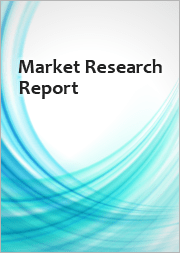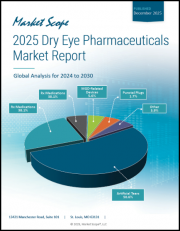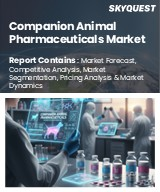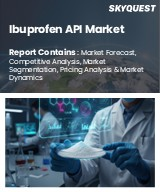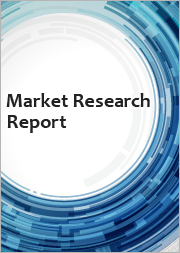
|
시장보고서
상품코드
1530795
세계의 의약품 시장 예측(-2030년) : 제품 유형별, 투여 경로별, 치료 영역별, 최종사용자별, 지역별 분석Pharmaceuticals Market Forecasts to 2030 - Global Analysis By Product Type (Branded Drugs, Generic Drugs, OTC Drugs, Biopharmaceuticals, Vaccines and Other Product Types), Route of administration, Therapy Area, End User and By Geography |
||||||
Stratistics MRC에 따르면, 세계 의약품 시장은 2024년 16억 달러 규모이며, 예측 기간 동안 8.4%의 CAGR로 성장하여 2030년에는 26억 달러에 달할 것으로 예상됩니다.
의약품은 질병의 진단, 치료, 예방 및 완화를 위해 개발된 약물을 말합니다. 이 분야는 신규 화합물의 발견부터 개발, 시험, 규제 당국의 승인, 생산, 유통에 이르는 전 과정을 포함합니다. 의약품에는 일반의약품부터 처방약, 백신, 생물학적 제제까지 다양한 제품이 포함됩니다. 이 산업은 의약품의 안전성, 유효성 및 품질을 보장하기 위해 고도의 규제를 받고 있으며, 광범위한 연구, 임상시험 및 FDA와 같은 당국이 정한 표준을 준수해야 합니다. 의약품은 현대 의료에서 중요한 역할을 하며, 다양한 건강 상태를 관리하고, 환자 결과를 개선하며, 공중 보건에 기여하는 등 중요한 역할을 하고 있습니다.
만성질환의 증가
만성질환 유병률의 증가는 지속적인 투약, 특수 치료, 혁신적 치료법에 대한 수요를 촉진하여 제약회사의 매출과 수익 증가로 이어지고 있습니다. 이러한 추세는 R&D 투자를 촉진하여 신약과 개량신약의 창출을 촉진합니다. 또한, 복잡한 건강 문제를 해결하기 위해 업계 내 제휴 및 협력 관계를 촉진하여 시장 성장을 촉진하고 있습니다.
약값 폭등에 대한 사회적 감시
세간의 따가운 시선은 약값을 억제하거나 낮추기 위한 규제 압력이나 입법 조치 강화로 이어질 수 있습니다. 또한, 풍문으로 인해 주가와 투자자의 신뢰에 영향을 미칠 수 있습니다. 기업들은 이익률 하락에 직면할 수 있으며, 신약 연구개발에 대한 투자를 방해하여 예측 기간 동안 성장을 저해할 수 있습니다.
보건의료에 대한 정부 지출 증가
정부의 투자 증가는 의료 인프라를 강화하고 필수 의약품의 광범위한 유통을 지원함으로써 제약 기업의 수요와 매출을 증가시킬 수 있습니다. 또한 R&D 이니셔티브에 자금을 지원하여 기술 혁신과 새로운 치료법의 도입을 촉진합니다. 또한, 정부 지출에는 종종 보조금 및 상환 제도가 포함되어 있어 환자에게 의약품을 더 저렴하게 만들어 시장 성장을 촉진하고 있습니다.
제네릭 의약품의 경쟁사
특허기간이 만료되면 제네릭 의약품 제조업체는 제네릭 의약품을 제조 및 판매할 수 있게 되고, 제네릭 의약품의 매출은 급감하게 됩니다. 제네릭 의약품의 존재로 인해 오리지널 의약품 제조업체는 제품 차별화를 위해 마케팅과 기술 혁신에 더 많은 투자를 해야 하기 때문에 경영 비용이 증가하게 됩니다.
COVID-19의 영향:
COVID-19는 제약 시장에 큰 영향을 미쳐 기술 혁신과 백신 및 치료제 개발을 가속화했습니다. 의약품, 진단약, 의료용품에 대한 수요를 증가시켜 많은 기업의 수익을 증가시켰습니다. 그러나 동시에 공급망에 혼란을 일으켜 임상시험을 지연시키고 자원을 압박했습니다. 이 위기는 업계에서 민첩성과 협력의 중요성을 강조하고, 향후 유행병에 대비한 세계 보건 준비와 회복력에 대한 빠른 진전과 새로운 노력을 가져왔습니다.
예측 기간 동안 브랜드 의약품 부문이 가장 큰 비중을 차지할 것으로 예상
브랜드 의약품은 특허로 보호되기 때문에 제약회사는 R&D 비용을 회수하고 추가 혁신에 자금을 지원할 수 있습니다. 브랜드 의약품은 높은 가격에 거래되는 경우가 많으며, 제조업체에 큰 수익과 이익을 가져다주며, 치료법을 발전시키고 미충족 의료 수요를 충족시키는 데 필수적입니다.
예측 기간 동안 CAGR이 가장 높을 것으로 예상되는 암 분야
전 세계적으로 암 발병률이 높아짐에 따라 효과적인 치료법에 대한 수요가 증가함에 따라 암 분야는 제약회사들의 최우선 과제로 떠오르고 있습니다. 이러한 초점은 표적치료제, 면역치료제, 맞춤의료와 같은 혁신적인 치료법 개발로 이어지며, 이는 높은 가격으로 거래되어 업계 내 지속적인 성장과 혁신을 보장하는 큰 수익을 창출합니다.
가장 큰 점유율을 차지하는 지역:
예측 기간 동안 북미가 가장 큰 시장 점유율을 차지할 것으로 예상 북미, 특히 미국은 세계 의약품 시장의 대부분을 차지하고 있습니다. 이 시장은 인구 고령화, 만성 질환의 증가, 혁신적인 치료법에 대한 높은 수요로 인해 강력한 성장세를 보이고 있습니다. 또한, 이 지역은 의약품 혁신의 선두주자이며, 연구개발에 많은 투자를 하고 있습니다.
CAGR이 가장 높은 지역:
아시아태평양은 헬스케어 수요 증가, 가처분 소득 증가, 헬스케어 서비스 접근성 확대로 인해 가장 높은 CAGR을 기록할 것으로 예상되며, 예측 기간 동안 가장 높은 CAGR을 유지할 것으로 예상됩니다. 중국, 인도와 같은 국가들은 인구가 많고 의료 인프라가 잘 갖추어져 있어 이러한 성장에 크게 기여하고 있습니다. 현지 기업들은 제네릭 의약품 시장의 주요 플레이어이며, 이 지역의 제약 산업 성장에 기여하고 있습니다.
무료 맞춤형 서비스:
이 보고서를 구독하는 고객은 다음과 같은 무료 맞춤화 옵션 중 하나를 사용할 수 있습니다.
- 기업 개요
- 추가 시장 기업의 종합적인 프로파일링(최대 3개사까지)
- 주요 기업 SWOT 분석(최대 3개사까지)
- 지역 세분화
- 고객의 관심에 따른 주요 국가별 시장 추정치, 예측, CAGR(주: 타당성 검토에 따른)
- 경쟁사 벤치마킹
- 제품 포트폴리오, 지리적 입지, 전략적 제휴를 기반으로 한 주요 기업 벤치마킹
목차
제1장 주요 요약
제2장 서문
- 개요
- 이해관계자
- 조사 범위
- 조사 방법
- 데이터 마이닝
- 데이터 분석
- 데이터 검증
- 조사 접근법
- 조사 정보 출처
- 1차 조사 정보 출처
- 2차 조사 정보 출처
- 가정
제3장 시장 동향 분석
- 성장 촉진요인
- 성장 억제요인
- 기회
- 위협
- 제품 분석
- 최종사용자 분석
- 신흥 시장
- COVID-19의 영향
제4장 Porter's Five Forces 분석
- 공급 기업의 교섭력
- 구매자의 교섭력
- 대체품의 위협
- 신규 참여업체의 위협
- 경쟁 기업 간의 경쟁 관계
제5장 세계의 의약품 시장 : 제품 유형별
- 브랜드 의약품
- 제네릭 의약품
- OTC 의약품
- 바이오의약품
- 백신
- 기타 제품 유형
제6장 세계의 의약품 시장 : 투여 경로별
- 경구
- 정제
- 캡슐
- 액체
- 시럽
- 주사
- 정맥내
- 근육내
- 피하
- 점적
- 국소
- 크림
- 연고
- 젤
- 패치
- 흡입
- 정량 흡입기
- 드라이 파우더 흡입기
- 네블라이저
- 경피
- 비강
- 기타 투여 경로
제7장 세계의 의약품 시장 : 치료 분야별
- 종양학
- 심혈관질환
- 신경학
- 호흡기질환
- 위장장애
- 감염증
- 당뇨병
- 기타 치료 분야
제8장 세계의 의약품 시장 : 최종사용자별
- 클리닉
- 병원
- 재택 케어 환경
- 연구·학술기관
- 기타 최종사용자
제9장 세계의 의약품 시장 : 지역별
- 북미
- 미국
- 캐나다
- 멕시코
- 유럽
- 독일
- 영국
- 이탈리아
- 프랑스
- 스페인
- 기타 유럽
- 아시아태평양
- 일본
- 중국
- 인도
- 호주
- 뉴질랜드
- 한국
- 기타 아시아태평양
- 남미
- 아르헨티나
- 브라질
- 칠레
- 기타 남미
- 중동 및 아프리카
- 사우디아라비아
- 아랍에미리트
- 카타르
- 남아프리카공화국
- 기타 중동 및 아프리카
제10장 주요 발전
- 계약, 파트너십, 협업, 합작투자
- 인수와 합병
- 신제품 발매
- 사업 확대
- 기타 주요 전략
제11장 기업 개요
- Pfizer Inc.
- Johnson & Johnson
- Roche Holding AG
- Novartis International AG
- Merck & Co., Inc.(MSD)
- Bristol-Myers Squibb
- Sanofi
- GlaxoSmithKline
- AstraZeneca
- AbbVie Inc.
- Eli Lilly and Company
- Bayer AG
- Amgen Inc.
- Takeda Pharmaceutical Company Limited
- Boehringer Ingelheim
- Gilead Sciences, Inc.
- Novo Nordisk A/S
- Teva Pharmaceutical Industries Ltd.
- Astellas Pharma Inc.
- Biogen Inc.
According to Stratistics MRC, the Global Pharmaceuticals Market is accounted for $1.6 billion in 2024 and is expected to reach $2.6 billion by 2030 growing at a CAGR of 8.4% during the forecast period. Pharmaceuticals are drugs and medications developed for use in medical diagnosis, treatment, prevention, and alleviation of diseases. This field encompasses the entire process from the discovery of new compounds to their development, testing, regulatory approval, production, and distribution. Pharmaceuticals include a wide range of products, from over-the-counter drugs to prescription medications, vaccines, and biologics. The industry is highly regulated to ensure drug safety, efficacy, and quality, requiring extensive research, clinical trials, and adherence to standards set by authorities like the FDA. Pharmaceuticals play a critical role in modern healthcare, enabling the management of various health conditions, enhancing patient outcomes, and contributing to public health.
Market Dynamics:
Driver:
Increasing incidence of chronic diseases increases
Increasing incidence of chronic diseases drives demand for ongoing medication, specialized treatments, and innovative therapies, leading to higher sales and revenue growth for pharmaceutical companies. This trend also stimulates research and development investments, fostering the creation of new and improved drugs. Additionally, it encourages partnerships and collaborations within the industry to address complex health challenges propelling the markets growth.
Restraint:
Public scrutiny of high drug prices
Public scrutiny can lead to increased regulatory pressure and legislative actions aimed at controlling or reducing drug prices. It may also result in reputational damage, affecting stock prices and investor confidence. Companies might face reduced profit margins, hampering their ability to invest in research and development for new drugs hampering its growth during the forecast period.
Opportunity:
Increased government spending on healthcare
Increased government nvestment enhances healthcare infrastructure and supports broader distribution of essential drugs, driving higher demand and sales for pharmaceutical companies. It also funds research and development initiatives, fostering innovation and the introduction of new therapies. Moreover, government spending often includes subsidies and reimbursement programs, making medications more affordable for patients encouraging growth of the market.
Threat:
Generic competition
Patents for branded drugs expire, generic drug makers can produce and sell cheaper versions of these medications, leading to a sharp decline in the sales of the original products. This increased availability of lower-cost alternatives drives down prices across the market, reducing profit margins for both brand-name and generic pharmaceutical companies thereby the presence of generics also forces branded drug manufacturers to invest more in marketing and innovation to differentiate their products, increasing operational costs.
Covid-19 Impact:
The COVID-19 pandemic profoundly impacted the pharmaceuticals market, accelerating innovation and the development of vaccines and treatments. It increased demand for medications, diagnostics, and healthcare supplies, boosting revenues for many companies. However, it also disrupted supply chains, delayed clinical trials, and strained resources. The crisis emphasized the importance of agility and collaboration in the industry, leading to rapid advancements and a renewed focus on global health preparedness and resilience against future pandemics.
The branded drugs segment is expected to be the largest during the forecast period
The branded drugs is expected to be the largest during the forecast period because these drugs, protected by patents, allow pharmaceutical companies to recoup research and development costs and fund further innovation. They often command higher prices, contributing to substantial revenue and profitability for their manufacturers and branded drugs remain crucial for advancing medical treatments and addressing unmet healthcare needs.
The oncology segment is expected to have the highest CAGR during the forecast period
The oncology segment is expected to have the highest CAGR during the forecast period owing to the high prevalence of cancer worldwide creates substantial demand for effective treatments, positioning oncology as a top priority for pharmaceutical companies. This focus leads to the development of innovative therapies, including targeted treatments, immunotherapy's, and personalized medicine, which command high prices and generate substantial revenue ensuring sustained growth and innovation within the industry.
Region with largest share:
North America is projected to hold the largest market share during the forecast period North America, particularly the U.S., represents a significant portion of the global pharmaceuticals market. The market is characterized by strong growth due to aging populations, increasing prevalence of chronic diseases, and high demand for innovative treatments. Further the region is a leader in pharmaceutical innovation, with substantial investments in research and development.
Region with highest CAGR:
Asia Pacific is projected to hold the highest CAGR over the forecast period as the Asia-Pacific region is experiencing significant growth due to increasing healthcare needs, rising disposable incomes, and expanding access to healthcare services. Countries like China and India are major contributors to this growth, with their large populations and improving healthcare infrastructure. Local companies are major players in the generic drug market, contributing to the region's growing pharmaceutical industry.
Key players in the market
Some of the key players in Pharmaceuticals market include Pfizer Inc., Johnson & Johnson, Roche Holding AG, Novartis International AG, Merck & Co., Inc. (MSD), Bristol-Myers Squibb, Sanofi, GlaxoSmithKline, AstraZeneca, AbbVie Inc., Eli Lilly and Company, Bayer AG, Amgen Inc., Takeda Pharmaceutical Company Limited, Boehringer Ingelheim, Gilead Sciences, Inc., Novo Nordisk A/S, Teva Pharmaceutical Industries Ltd., Astellas Pharma Inc. and Biogen Inc.
Key Developments:
In July 2024, Johnson & Johnson strengthened pipeline to lead in atopic dermatitis with acquisition of Yellow Jersey Therapeutics. The company is leveraging a multi-pathway approach to transform treatment in atopic dermatitis and other immune-mediated diseases
In June 2024, Pfizer Inc. and BioNTech received positive CHMP opinion for Omicron JN.1-adapted COVID-19 vaccine in the European Union. The updated COVID-19 vaccine is tailored to the Omicron JN.1 lineage of SARS-CoV-2 and is recommended for individuals 6 months of age and older
In June 2024, Bayer receives breakthrough therapy designation in China for BAY 2927088 in high unmet need patients with HER2-mutant non-small cell lung cancer. The Center for Drug Evaluation in China has granted breakthrough therapy designation to expedite the development
Product Types Covered:
- Branded Drugs
- Generic Drugs
- OTC (Over-the-Counter) Drugs
- Biopharmaceuticals
- Vaccines
- Other Product Types
Route of administrations Covered:
- Oral
- Injectable
- Topical
- Inhalation
- Transdermal
- Nasal
- Other Route of administrations
Therapy Areas Covered:
- Oncology
- Cardiovascular Diseases
- Neurology
- Respiratory Diseases
- Gastrointestinal Disorders
- Infectious Diseases
- Diabetes
- Other Therapy Areas
End Users Covered:
- Clinics
- Hospitals
- Home Care Settings
- Research & Academic Institutes
- Other End Users
Regions Covered:
- North America
- US
- Canada
- Mexico
- Europe
- Germany
- UK
- Italy
- France
- Spain
- Rest of Europe
- Asia Pacific
- Japan
- China
- India
- Australia
- New Zealand
- South Korea
- Rest of Asia Pacific
- South America
- Argentina
- Brazil
- Chile
- Rest of South America
- Middle East & Africa
- Saudi Arabia
- UAE
- Qatar
- South Africa
- Rest of Middle East & Africa
What our report offers:
- Market share assessments for the regional and country-level segments
- Strategic recommendations for the new entrants
- Covers Market data for the years 2022, 2023, 2024, 2026, and 2030
- Market Trends (Drivers, Constraints, Opportunities, Threats, Challenges, Investment Opportunities, and recommendations)
- Strategic recommendations in key business segments based on the market estimations
- Competitive landscaping mapping the key common trends
- Company profiling with detailed strategies, financials, and recent developments
- Supply chain trends mapping the latest technological advancements
Free Customization Offerings:
All the customers of this report will be entitled to receive one of the following free customization options:
- Company Profiling
- Comprehensive profiling of additional market players (up to 3)
- SWOT Analysis of key players (up to 3)
- Regional Segmentation
- Market estimations, Forecasts and CAGR of any prominent country as per the client's interest (Note: Depends on feasibility check)
- Competitive Benchmarking
- Benchmarking of key players based on product portfolio, geographical presence, and strategic alliances
Table of Contents
1 Executive Summary
2 Preface
- 2.1 Abstract
- 2.2 Stake Holders
- 2.3 Research Scope
- 2.4 Research Methodology
- 2.4.1 Data Mining
- 2.4.2 Data Analysis
- 2.4.3 Data Validation
- 2.4.4 Research Approach
- 2.5 Research Sources
- 2.5.1 Primary Research Sources
- 2.5.2 Secondary Research Sources
- 2.5.3 Assumptions
3 Market Trend Analysis
- 3.1 Introduction
- 3.2 Drivers
- 3.3 Restraints
- 3.4 Opportunities
- 3.5 Threats
- 3.6 Product Analysis
- 3.7 End User Analysis
- 3.8 Emerging Markets
- 3.9 Impact of Covid-19
4 Porters Five Force Analysis
- 4.1 Bargaining power of suppliers
- 4.2 Bargaining power of buyers
- 4.3 Threat of substitutes
- 4.4 Threat of new entrants
- 4.5 Competitive rivalry
5 Global Pharmaceuticals Market, By Product Type
- 5.1 Introduction
- 5.2 Branded Drugs
- 5.3 Generic Drugs
- 5.4 OTC (Over-the-Counter) Drugs
- 5.5 Biopharmaceuticals
- 5.6 Vaccines
- 5.7 Other Product Types
6 Global Pharmaceuticals Market, By Route of administration
- 6.1 Introduction
- 6.2 Oral
- 6.2.1 Tablets
- 6.2.2 Capsules
- 6.2.3 Liquids
- 6.2.4 Syrups
- 6.3 Injectable
- 6.3.1 Intravenous
- 6.3.2 Intramuscular
- 6.3.3 Subcutaneous
- 6.3.4 Infusions
- 6.4 Topical
- 6.4.1 Creams
- 6.4.2 Ointments
- 6.4.3 Gels
- 6.4.4 Patches
- 6.5 Inhalation
- 6.5.1 Metered-Dose Inhalers
- 6.5.2 Dry Powder Inhalers
- 6.5.3 Nebulizers
- 6.6 Transdermal
- 6.7 Nasal
- 6.8 Other Route of administrations
7 Global Pharmaceuticals Market, By Therapy Area
- 7.1 Introduction
- 7.2 Oncology
- 7.3 Cardiovascular Diseases
- 7.4 Neurology
- 7.5 Respiratory Diseases
- 7.6 Gastrointestinal Disorders
- 7.7 Infectious Diseases
- 7.8 Diabetes
- 7.9 Other Therapy Areas
8 Global Pharmaceuticals Market, By End User
- 8.1 Introduction
- 8.2 Clinics
- 8.3 Hospitals
- 8.4 Home Care Settings
- 8.5 Research & Academic Institutes
- 8.6 Other End Users
9 Global Pharmaceuticals Market, By Geography
- 9.1 Introduction
- 9.2 North America
- 9.2.1 US
- 9.2.2 Canada
- 9.2.3 Mexico
- 9.3 Europe
- 9.3.1 Germany
- 9.3.2 UK
- 9.3.3 Italy
- 9.3.4 France
- 9.3.5 Spain
- 9.3.6 Rest of Europe
- 9.4 Asia Pacific
- 9.4.1 Japan
- 9.4.2 China
- 9.4.3 India
- 9.4.4 Australia
- 9.4.5 New Zealand
- 9.4.6 South Korea
- 9.4.7 Rest of Asia Pacific
- 9.5 South America
- 9.5.1 Argentina
- 9.5.2 Brazil
- 9.5.3 Chile
- 9.5.4 Rest of South America
- 9.6 Middle East & Africa
- 9.6.1 Saudi Arabia
- 9.6.2 UAE
- 9.6.3 Qatar
- 9.6.4 South Africa
- 9.6.5 Rest of Middle East & Africa
10 Key Developments
- 10.1 Agreements, Partnerships, Collaborations and Joint Ventures
- 10.2 Acquisitions & Mergers
- 10.3 New Product Launch
- 10.4 Expansions
- 10.5 Other Key Strategies
11 Company Profiling
- 11.1 Pfizer Inc.
- 11.2 Johnson & Johnson
- 11.3 Roche Holding AG
- 11.4 Novartis International AG
- 11.5 Merck & Co., Inc. (MSD)
- 11.6 Bristol-Myers Squibb
- 11.7 Sanofi
- 11.8 GlaxoSmithKline
- 11.9 AstraZeneca
- 11.10 AbbVie Inc.
- 11.11 Eli Lilly and Company
- 11.12 Bayer AG
- 11.13 Amgen Inc.
- 11.14 Takeda Pharmaceutical Company Limited
- 11.15 Boehringer Ingelheim
- 11.16 Gilead Sciences, Inc.
- 11.17 Novo Nordisk A/S
- 11.18 Teva Pharmaceutical Industries Ltd.
- 11.19 Astellas Pharma Inc.
- 11.20 Biogen Inc.






